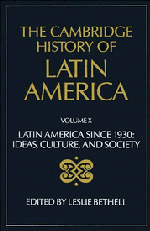Book contents
- Frontmatter
- 1 The multiverse of Latin American identity, c. 1920–c. 1970
- 2 Latin American narrative since c. 1920
- 3 Latin American poetry, c. 1920–1950
- 4 Latin American poetry since 1950
- 5 Indigenous literatures and cultures in twentieth-century Latin America
- 6 Latin American music, c. 1920—c. 1980
- 7 Latin American architecture, c. 1920–c. 1980
- 8 Latin American art since c. 1920
- 9 Latin American cinema
- 10 Latin American broadcasting
- Bibliographical essays
7 - Latin American architecture, c. 1920–c. 1980
Published online by Cambridge University Press: 28 March 2008
- Frontmatter
- 1 The multiverse of Latin American identity, c. 1920–c. 1970
- 2 Latin American narrative since c. 1920
- 3 Latin American poetry, c. 1920–1950
- 4 Latin American poetry since 1950
- 5 Indigenous literatures and cultures in twentieth-century Latin America
- 6 Latin American music, c. 1920—c. 1980
- 7 Latin American architecture, c. 1920–c. 1980
- 8 Latin American art since c. 1920
- 9 Latin American cinema
- 10 Latin American broadcasting
- Bibliographical essays
Summary
introduction
By the 1870s the majority of the newly independent Latin American countries appeared—to greater or less degree—to be on the road to social and political stability. Relative economic prosperity resulting from Latin America’s accelerated integration into world economy and the arrival of thousands of immigrants from all over the world, but above all from Europe (especially the Mediterranean basin), had at least two important consequences for Latin American architecture. First, it brought skilled labour that was quite different from the local workmanship that had sufficed until then; secondly, a new acculturation on a global scale meant exposure to styles and sensibilities distinct from those which had prevaileduntil then. Between the 1870s and the 1920s governments and the new rising bourgeoisie used architecture as one of the most visible means of giving themselves an aura of respectability, and they did so by imitating European and North American models.
During this period neo-classicism—refined or popular, as it was handled by masons steeped in the millennarian formulas of the Old World—began to disappear, giving way to eclectic designs typical of the nineteenth century: neo-romanesque or neo-gothic, Italian Renaissance, Beaux-Arts, or simply the picturesque styles of the European countryside: Andalusian, Basque, Norman, Swiss or English, appropriated for suburban residences or homes built in the mountains or at the beach. An ingenious mechanism then came into play: obligatory styles for various types of buildings. Thus, for example, the ‘Roman’ (with the addition of a cupola) lends itself to legislative palaces, and the ‘Italian’ or the ‘French’ (complete with mansard roof in tropical climates) is required for most public structures or for private buildings that lay claim to a certain degree of nobility.
- Type
- Chapter
- Information
- The Cambridge History of Latin America , pp. 365 - 392Publisher: Cambridge University PressPrint publication year: 1995



